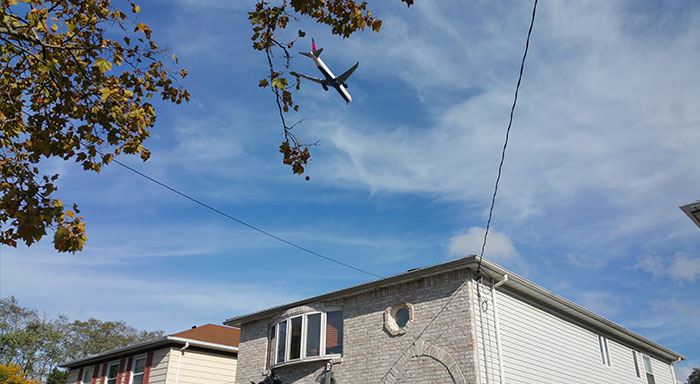Forum Photo by Michael V. Cusenza
A case study on LaGuardia Airport shows that increased noise can pose health threats—including cardiovascular disease—to residents and workers in neighborhoods underneath flight paths.
By Michael V. Cusenza
Aircraft noise can pose remarkably serious health threats—including cardiovascular disease—to the communities over which planes fly, and the health costs associated with said noise from changing flight patterns over populated urban landscapes far outweigh the benefits of reduced flight times, according to a new case study conducted at Columbia University and Queens Quiet Skies.
Researchers who authored “The Trade-Off between Optimizing Flight Patterns and Human Health: A Case Study of Aircraft Noise in Queens,” focused on flights from LaGuardia Airport that have historically flown over Flushing Meadows Corona Park and the U.S. Tennis Center—known as the TNNIS route—to explore the trade-offs between more efficient flight routes and suffering on the ground.
Initially, the TNNIS route was implemented annually for the duration of the US Open tennis tournament. The year-round use of TNNIS at La Guardia that was instituted in 2012 was a result of flight automation in New York City. No environmental assessment or environmental impact statement was ever performed on the route.
“Flights from LaGuardia airport have historically flown over Flushing Meadows in Queens,” noted Peter Muennig, MD, professor of Health Policy and Management at the Mailman School. “During US Open tennis matches, the residents of certain neighborhoods in Queens had to endure heavy airplane traffic over their homes, but it only lasted a few weeks. Now, they have to contend with it year-round.”
Scientists concluded that, “Despite increases in efficiency, flight automation systems without a careful assessment of noise might generate flight paths over densely populated areas and cause serious health conditions for the overflown communities.”
For the analysis, researchers compared the costs and quality-adjusted life years gained associated with reverting to pre-2012 flight patterns seen prior to the year-round use of TNNIS. The TNNIS climb increased airplane noise to above 60dB over some of the most densely populated areas of the city. The serious health threats produced by the increase in noise could result in the loss of up to one year of an affected person’s lifespan.
“Airports in the U.S. have gradually been transitioning to automated flight systems,” Muennig said. “These systems generate new flight paths over populated areas. While they can improve flight efficiency, the increased noise associated with these novel flight patterns potentially pose serious health threats to nearby communities—including cardiovascular disease and anxiety disorder as consequences of noise.”
While researchers noted that the LaGuardia case study “should by no means be taken as a blanket assessment of changes to flight patterns that might reduce airline fuel consumption, increase productivity, and reduce global warming,” the models and findings “can be used to better understand the trade-offs that new technologies bring.”
“Our study focuses on health and economic impacts of a single flight route as a result of flight automation, however, our analysis uses inputs that may be generalizable to other settings,” Muennig added. “The results point to the strong need for careful study of public health impacts of such changes before they are implemented.”

